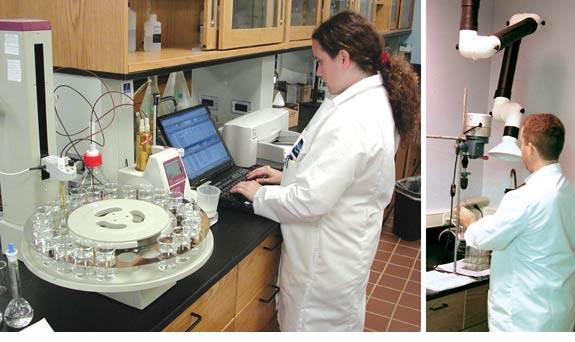 Deborah Webb, student intern,working on the Alkalinity Titrator; Matt Jablonski, staff chemist, measures chlorophyll concentrations.
Deborah Webb, student intern,working on the Alkalinity Titrator; Matt Jablonski, staff chemist, measures chlorophyll concentrations.
Every day, Laura Casino, District chemist, takes water samples from ice-filled coolers delivered to the lab for chlorophyll analysis. Since chlorophyll degrades quickly, the samples are collected in opaque containers that protect it from any light and then preserved in ice. Laura removes the containers, taking short breaks between dips into the ice to warm her hands.
To maintain the samples, Laura continues the sample preparation in a room with fluorescent lights, which are covered with film that only transmits red light waves to protect the chlorophyll. She carefully measures each sample in liters and pours it through a glass fiber filter to capture the algae containing the chlorophyll. The filter is then placed into a freezer to preserve the sample until the next step in the process.
Next, the chlorophyll must be suspended in acetone. Laura takes the filter containing the sample and places it into a tissue grinder with acetone. As the grinder rips apart the filter, the glass fibers tear open the algae cells and release the chlorophyll into the acetone. The acetone solution containing the chlorophyll is placed into a test tube and is ready for the final step in the testing process.
Laura withdraws and transfers the sample from the test tube to the spectrometer, the instrument that measures the amount of chlorophyll in the liquid. After the instrument is loaded, the testing begins.
For more than 20 years, the District’s chemistry lab has performed important but largely unseen work in protecting water resources.
With a staff of only ten people, including six chemists, the lab processes between 3,000 and 3,500 water samples per year. With approximately 20 tests per sample, this translates to about 65,000 tests per year.
District staff relies on the lab to test water samples for several different purposes, such as monitoring high nutrient levels, measuring water clarity or identifying potential issues such as saltwater intrusion within the aquifer.
For example, staff may receive calls regarding dead fish in a water body. Water samples are tested to identify any problems that may be the cause.
In newly constructed developments, regulatory staff collects samples of nearby water bodies for the lab to test and confirm that construction activities such as clearing and grading property are not significantly impacting the water clarity.
The samples are tracked through the Laboratory Information Management System (LIMS) database. LIMS contains testing profiles and schedules sample times based on the requests of project managers. The samples are brought into the lab by field staff and preserved until they are ready for testing.
Chemists use LIMS to create work lists on the day of testing and load the samples into test instruments at eight different workstations. Computers linked to instruments capture the data and publish it in LIMS to be reviewed by the chemists. A typical sample takes about six weeks to complete testing.
To confirm the findings, the information is compared to historical data and submitted for validation.
“Quality control is a very important part of the testing process,” said Mark Rials, District chemistry laboratory manager. “The lab conducts approximately 30,000 tests in the form of quality control, calibration and retesting or verification testing to determine that the sample result was accurate.”
The District’s lab is certified by the National Environmental Laboratory Accreditation Council in 36 parameters and two categories. It operates based on a set level of quality measures in accordance with the council. To maintain the accreditation, the lab undergoes site inspections once every two years by the state of Florida.
Based on the District’s extensive quality criteria, the lab provides water quality data to other agencies upon request. The state of Florida uses the District’s water quality data to set total maximum daily loads (TMDLs) on rivers such as the Peace and Myakka.
TMDLs are the maximum amount of a given pollutant that a water body can receive and still meet water quality standards.
Although the work of the lab is often done behind the scenes, the staff plays a significant role in the functions of the District. The District offers an opportunity to produce water quality data that achieves a very high standard of excellence among environmental testing laboratories.
“I’m very proud to have an opportunity to work with the caliber of chemists the District has on its staff,” said Rials.
